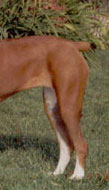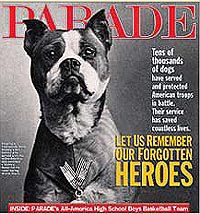Eyes, Ears, Coat, Color, Feet and Tail!
This page has information on all of these issues!
NOSE - The nose is large with wide, open nostrils. The nose may be any color.
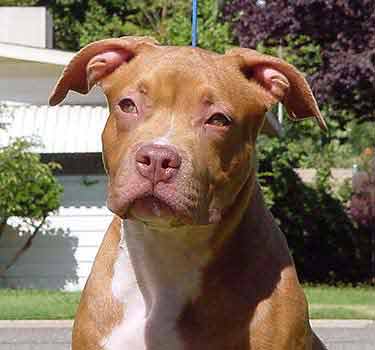
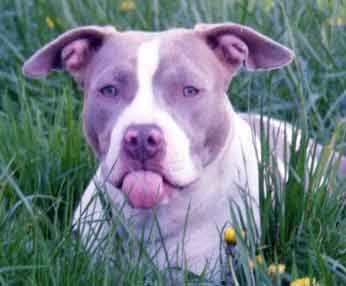
Two totally sweet looking dogs showing different nose colors. The left dog has a red nose leather and the dog on the right has what is known as a butterfly nose. Dark with lighter patches. Either of these noses is perfectly acceptable. Nose color does not matter. Nanny nanny boo boo!!!!
EYES - Eyes are medium size, round to almond-shaped, and set well apart and low on the skull. All colors are equally acceptable except blue,
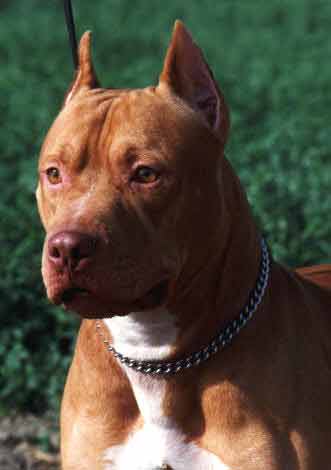
A
B
Photo shows correct almond shaped eyes (A) and correct round eyes (B). More squinted eyes are not desired but the amount of sun can cause squinting which should be taken into account. Similarly if the eyes are any rounder or more bulging than those in B it is not preferred. Bulging eyes are a fault.
Serious fault: blue eyes. Haw should not be visible. SEE FAULTS PAGE
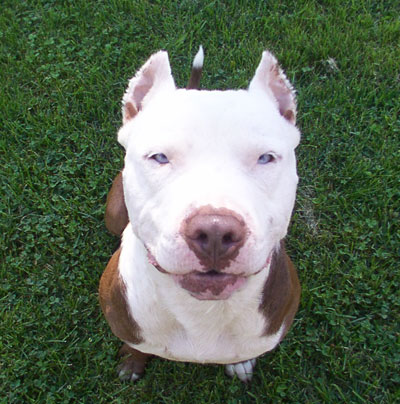
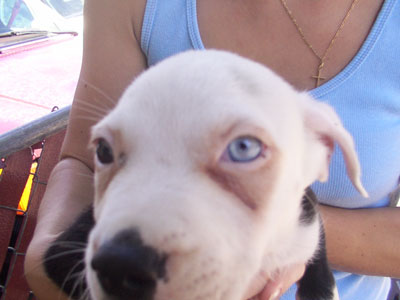
Serious Faults: Bulging eyes; both eyes not matched in color; blue eyes . SEE FAULTS PAGE AND ABOVE
EARS - Ears are high set and may be natural or cropped without preference. If natural, semi-prick or rose are preferred.
.
pic1 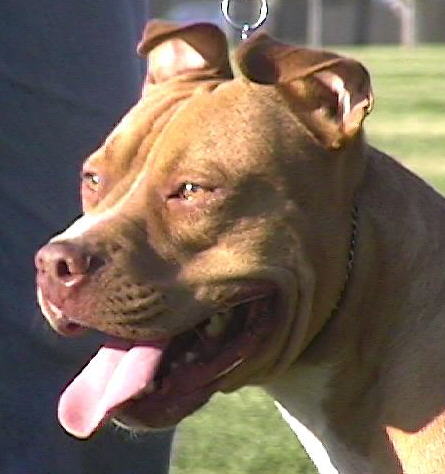 pic1a
pic1a
pic2 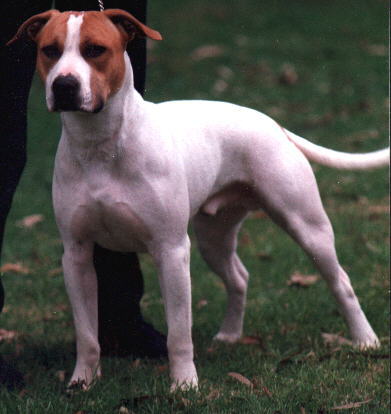 pic3
pic3 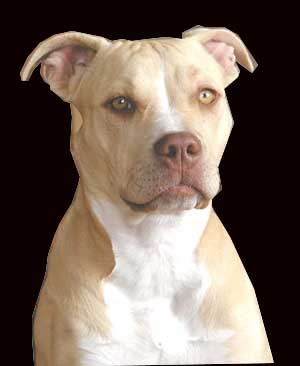
FIGURE 10A - Pic1 (photo credit Ruth Kramer Arkay Kennels) shows a dog with uncropped "half-prick" ears. The half-prick ear is a preferred shape and is not often recognized by judges even those very familiar with the APBT. Pic2 (photo credit Ruth Kramer Arkay Kennels) and pic3 (photo credit Candy from Colorado) are natural rose ears of different lengths this is a more common natural ear for the APBT. The natural ear in past standards was considered preferred over a cropped ear but because the common image of the APBT is with cropped ears even then excellent dogs with natural ears were often overlooked.
Minor fault: Prick or flat, wide ears are not desired (SEE FAULT PAGE)
Short-coated-
The coat is glossy and smooth, close, and moderately stiff to the touch.
Faults: Curly, wavy, or sparse coat.
Disqualification: Long coat
I have seen "APBTs" that have hair almost 1 inch long that sheds all year long (yuck no offense to long haired breed but my wife is a groomer and we prefer wash n wear LOL). Anyway, long hair on the APBT is a Disqualification!!!. The place where hair tends to be longest is in the hackles or be blades. As a general rule 0.5 inches or less is a good short coat from hair measured at the shoulders, beyond a half inch in length and in my opinion you are verging on medium coat.
Any color, color pattern, or combination of colors is acceptable, except for merle.
Disqualification: Merle

EVEN GREEN AND PINK!!!!
FEET
The feet are round proportionate to the size of the dog, well arched, and tight. Pads are hard, tough, and well cushioned. Dewclaws may be removed.
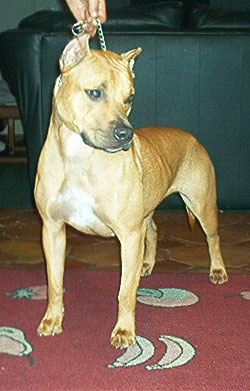
Dog with nice round tight feet
Fault: Splayed feet
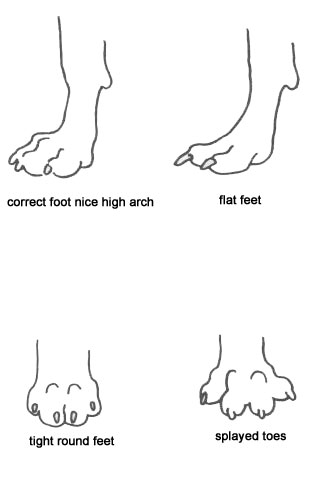
Diagram showing what correct feet are. The two left figures are correct. The two right figures are the common faults that are overlooked. Feet are a vital part of this breed as strength and speed of movement originates in a solidly constructed foot.
TAIL
The tail is set on as a natural extension of the topline, and tapers to a point. When the dog is relaxed, the tail is carried low and extends approximately to the hock.
|
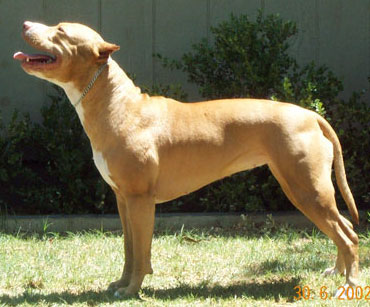
Shows a proper tail length and carriage for a relaxed dog
The relatively short tail is set low, thick at the base and tapers to a point.
UKC JUDGE and APBT breeder: I see few judges that actually FEEL to determine tail set. There are many dogs in the breed that are so muscled (not to mention fat..lol) in the rump that the eye cannot tell the actual set in relation to the spine . Same goes for the little dip in the withers. Only feeling the spine will tell the true story. "The tail is set on as a natural extension of the top line, and tapers to a point." In my opinion, this is a poorly worded statement, because of the above. The APPARENT tail set will vary with the condition on the dog, but the ACTUAL tail set will never vary with respect to the spine.
When the dog is moving, the tail is carried level with the backline.
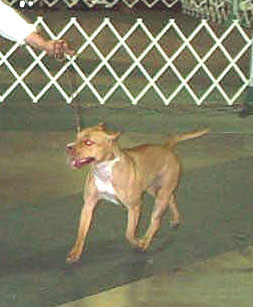
Shows a dog moving with tails in acceptable preferred positions.
When the dog is excited, the tail may be carried in a raised, upright position, but never curled over the back
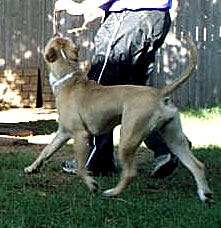
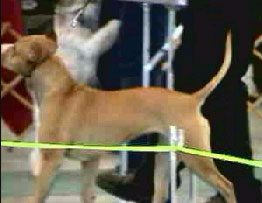
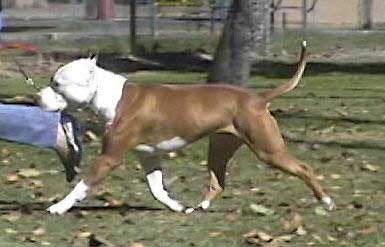
This female in the first picture is displaying an excited/challenge tail. The tail shows a slightly exaggerated curl with a slightly higher tail set which would take away a point but is not considered a fault. The female and the male in the second and third pictures have preferred version of the challenge tail no points deducted.
Note from APBT breeder about terminology of the standard
""Tail should not be measured to the hock..."" Tail should be judged in comparison to overall body length as was once stated in the standard. The reason....Length of hock can distort the appearance of the tail length. Short hock can make a good tail appear short....Long hock can make a short tail appear correct or even long. Overall balance between parts is necessary in the APBT so tail length and body length are in direct correlation and both good and bad can be carried on an incorrect wheel base.
( 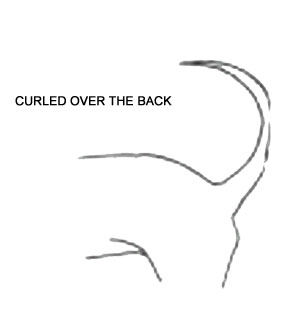 ).
). 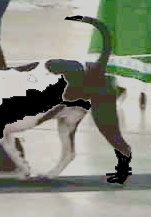
graphics depicting gay tails. Notice they curl up and over the back. This is very different from a challenge tail.
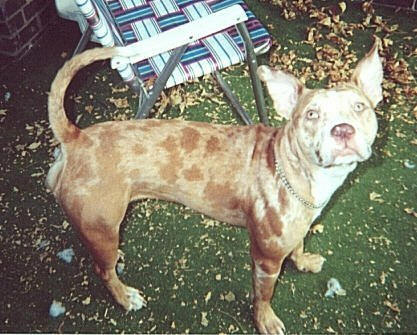
a merle with a gay tail.
This graphics above and the photo show what a gay tail is. Notice the tail curls completely over the back. The graphic shows a low tail set with a curl over the back. The photo is a very high tail set with a serious "over the back" curl. A serious fault 5-10 pts depending on severity
This drawing shows a dog with a lower tail set than the female above, which is more correct, but the tail is curled up and over the back of the dog which is a serious fault
Fault: Long tail (tail tip passes beyond point of hock) .

Shows a tail that is just a little too long and will pass the hock by about an inch when stretched down.
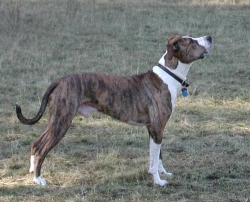
Shows a dog with a long tail with a serious curl at the end (great natural stack position though)
Serious faults: Gay tail (not to be confused with challenge tail) see the above photographic display; kinked tail. (
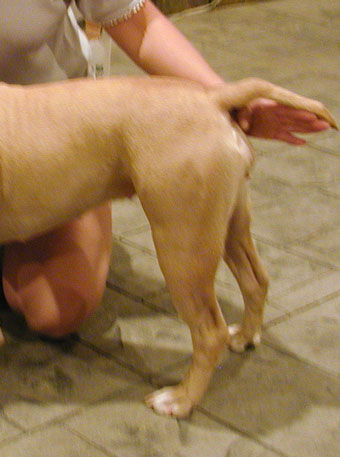 P
P
Shows a dog with a kinked tail a serious fault 10 pts
Disqualification: Bobbed tail
